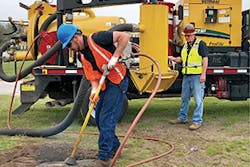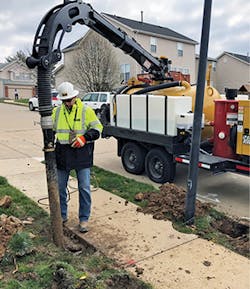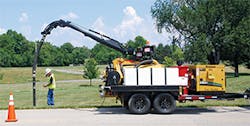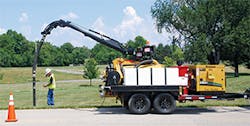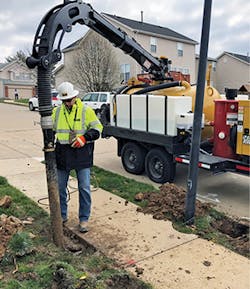The city officials of a rural Florida town had a big problem—a problem so big that it spanned across acres of clay and rocky soil in the steamy Sunshine State.
This town’s municipal government had misplaced its oldest gas lines, and they needed Vac-Tron Equipment to find them, says Brian Showley, vice president for Vac-Tron Equipment LLC. Of course, these gas lines weren’t lost like a spare sock in a drier or hidden like car keys after a toddler gets into mischief. Long-retired municipal gas, electrical, and water lines in communities that have existed for nearly a century sometimes weren’t tracked over the years as employees with institutional knowledge retired.
In this community, it was time to make an updated map with all of the region’s existing and retired pipes so new developments could work around those pipes. The lost pipes are known as “impossible locates,” and the job might be time-intensive, but it’s a common need for communities whose infrastructure maps no longer include pipes from the early 1900s. It’s a job that’s far from impossible for vacuum and hydro excavators.
“Over the years, they’ve just lost contact with where these lines are,” says Showley. “It can be acres of locates. There’s no rhyme or reason; they just say, ‘I know it’s in this area, you have to go find it.’ It’s time-consuming but it’s a necessary evil because it’s got to get done.”
Sometimes, job sites are too deep, too large, or too muddy for a traditional excavator or backhoe to tackle the job. Instead, operators rely on vacuum and hydro excavators to handle muddy or watery jobs. More so, vacuum and hydro excavators are well-equipped for giant jobs that include large surface areas, deep and muddy ground, or underwater excavation. These biggest-of-the-bunch jobs are often well-suited for vacuum and hydro excavators because of their unique approach and ability to avoid accidental damage.
Vacuum and hydro excavators can tackle extremely large jobs that cover many acres (like impossible locates), dive deep into the water (such as in the case of port renovation), and require maneuvering in highly viscous and watery environments.
Vacuum and hydro excavators can take on nearly any large job operators can throw their way, says Clayton Thompson, president of Done-Rite Daylighting Oilfield Services Ltd., a hydro-vacuum service in British Columbia, Canada.
“There are no excavations too large for our industry to handle,” he says.
He added that these machines have become a much more essential part of large job sites due to the need for different types of excavators, as well as water and fluid removal on larger job sites. As job sites grow and vacuum excavators become more efficient, it’s becoming essential to have these positive displacement pumps to create a vacuum, as well a high-pressure water pump with a large capacity to cut the ground and remove the material.
“Having some of the largest equipment built in the industry is quintessential to complete these big projects,” he says.
How do vacuum and hydro excavators work? Each type of excavator has similar purposes but is different in the methods that it actually uses to displace and remove soil and debris.
Vacuum excavation is a land-based excavation method that uses high-velocity air to penetrate the soil and break up the material for underground work, typically related to underground utility work. The material is expanded, broken up, and removed from the hole by a truck-mounted vacuum for construction, surveying, or maintenance purposes. It is used in situations where a backhoe would cause damage or wouldn’t be as efficient. Some examples of this technology in use are underground utility verification, excavation inside buildings, catch basin cleaning, utility line service terminations, clearing environmental boring holes, and precise removal of soil either vertically or horizontally and of a specific size for utility pre-screening surveying. After the job is done, the hole is typically backfilled.
Hydro excavation is a land- and water-based method that uses high-powered water pumps to break up the soil and turn it into mud. A pump simultaneously removes that mud from the service area by a truck-mounted vacuum system, leaving a hole. The debris is sucked up to a tank. Hydro excavation is used for utility maintenance and installation, landscaping, and underwater excavation, such as at shorelines, ports, and beaches. The suction excavator provides suction through a wide pipe. If backfill is needed for land-based operations, extra dry fill is sometimes required. Depending on the type, some hydro excavators are designed to keep the reclaimed soil relatively dry.
Showley says vacuum and hydro excavators are a great tool for acres-wide impossible locates because the air-based excavation can blow dirt away without damaging operational pipes or other buried resources. He says their vacuum excavation comes with a dirt recovery system that can replace the soil when the job is complete. Water-based hydro excavation is helpful in areas like Florida where soil can become incredibly dense, going from sand to rock to clay within the same acre.
“The only way to do an ‘impossible locate’ is to do it with vacuum because you’re just digging a trench from one end to the other and digging until you find something,” says Showley. “If we go in there with a backhoe, we’re going to damage something. It’s just too big of a risk.”
In some of these situations, the municipal staff has maps that were unearthed from basements and warehouse storages that are hand-drawn. The utility lines in those maps give a rough idea of where to begin the search, but even so, older lines may exist that the mapmakers didn’t know about. Sometimes, lines are created and disconnected and lost to memory when the staff turns over. Perhaps not all retired utility lines were drawn when maps were transferred to digital environments.
In some situations, he says, impossible locates become an Easter egg hunt. “The bottom-line to it is when it comes to an impossible locate, they need to go to whatever lengths they need to to find the line,” he says.
Vacuum and hydro excavation make it possible because of the excavator’s ability to quickly tear into the soil. Operators trench across the area in question and continue to case an area until a line is located, and then that line is traced to its origin or to a point on the map where the line is known to exist. “The only way to really go in there and see what’s in there is to trench across it. They not only find that line, but they’re finding other lines that they didn’t know were there,” he says.
When the job is done, a new map is made, and the excavating team replaces the soil with backfill. The vacuum and hydro excavation methods are strong enough to cut through tough clay but gentle enough not to break 100-year-old lines that might be corroded with rust. Every job reveals some mystery, but sometimes it takes the length of several football fields before they’ve struck “gold.”
Jobs aren’t always big in terms of having a wide surface area. Sometimes you have to deal with extremely rocky conditions. Ditch Witch, an underground utility construction company, says one of their customers, West Pacific Drilling, faced a challenge where a team worked on a job site that was 90% hard rock, much denser than the rock they typically had to bore through on an everyday job. They knew they were going to have a long day ahead of them as their drills got to work on the dense rock.
“Between June and July, the crew deployed 1,000-foot and 800-foot bores. To finish on time, the crew was on the job site 24 hours a day. A first shift would operate for 10 hours, spending the remainder of their time on maintenance and upkeep,” states Ditch Witch.
During all those days and nights, West Pacific Drilling operators were running drills, which required constant fluid flow. But that presented its own challenge because excess fluid runoff made the area muddy and difficult to drill, so they used a vacuum excavator to remove the fluid and mud. A dry work site is important not only for the drill but also for worker safety and to avoid environmental runoff contamination.
“The importance of minimizing maintenance and maximizing reliability can’t be stressed enough when time is tight and underground conditions are taxing the equipment,” says Loyal Kuenzi, operations manager at West Pacific Drilling, according to a Ditch Witch release. “Machines that are easy to maintain are important, but so is being backed up by a reliable dealer. With the Ditch Witch dealership, if we needed additional rental equipment or ran into a snag on the job, they were available and ready to help.”
Another form of large job where hydro and vacuum excavators can be the right tool for the job includes huge ditches. Thompson says that his company was digging a ditch 300 meters long, 12 meters wide, and 6 to 8 meters in depth, and they relied on vacuum/hydro excavators because the ground was nearly frozen solid in the harsh Canadian winter. Permafrost, ice, snow, and mud combined for a complicated slurry that could damage some forms of excavators, but hydro and vacuum excavators were well-suited for the challenge.
Hydro excavators could simultaneously melt ice and blast through dirt, making it the optimum tool for these frigid conditions. Even so, Thompson says this job wasn’t a walk in the park by any means and expertise with these type of job sites came into play in a big way.
“The project took a collaboration of companies working around the clock for 4–5 months straight, due to the extreme weather of our local climate in the winter creating harsh ground conditions,” he says. “With decades in this industry, we have excavated with hydro-vac hundreds of these sites.”
Vacuum and hydro excavators have evolved over the past decades, and newer models are significantly more powerful than the first iterations of these excavators. The introduction of components like hydraulics has made these tools significantly more powerful and more dexterous.
“Within the last two decades, our industry of hydro excavation utilizing vacuum to remove the desired material has grown from locating buried facilities and utilities, to completely digging the entire work areas including sensitive pipelines, to entire plant sites,” says Thompson.
Showley says vacuum and hydro excavators have changed significantly even in the past decade—and innovations happen every year as components become faster, stronger, and more durable.
“Compared to even 10 years ago, there’s a lot more power available to the industry,” he says. “There’s so much more power within the vacuum industry.”
He says improvements range from the introduction of hydraulics into components such as booms, the invention of better water pumps for hydro excavation, and smaller and stronger air compressors for vacuum excavation.
Hydraulic booms have been among the most helpful innovations introduced into the industry, making it far simpler to maneuver the booms quickly and precisely.
boom on an LP 873 SDT trailer vac
“These manufacturers are constantly working to improve their product,” says Showley of vacuum component manufacturers across the industry, which makes it possible for hydro-vac excavator manufacturers to create better products. “All that combined together is what’s giving us the better performance.”
Soft digging techniques are preferred in specific situations because of the safety benefits. Vacuum/hydro excavation eliminates the possibility of line damage and injury as a result of accidental trench cave-in. It can also avoid dangerous situations such as causing an explosion due to breaking an unseen gas line. It can also avoid municipal damage, such as causing loss of water due to a water line or incurring a significant fine due to breaking an expensive line.
“It’s been proven that vacuum is the safest way to dig,” says Showley.
He says vacuum and hydro excavators are also used to prevent potentially dangerous situations, such as a metal gas pipe exploding due to wear and tear due to corrosion, by being used to install anode bags. Operators use vacuum or hydro excavators to create small boring holes down to an old gas line, and every 25 to 30 feet, an anode bag is installed to divert off static electricity created from the environment. The static electricity could ignite gas if there is a leak, and the anode bags are seen as a safety stopgap in situations where a municipality cannot afford to replace gas lines yet. He added that he’s seeing more of these methods used due to the aging nature of the US gas line infrastructure.
Thompson says now that vacuum excavators can replace other forms of excavators, they can make job sites safer. “With the goal being zero injury/zero incident and a mindset geared toward safety first, today’s dig sites are consisting of more large excavations being performed using hydro-vac,” he says.
He says vacuum and hydro excavation is a safer way to dig because it eliminates accidental damage to unseen items and can also avoid some workplace injuries associated with types of excavators.
“These procedures make sure vacuum excavation is done before anything mechanical…to help protect the operators and the community,” he says.
Thompson agrees, saying hydro and vacuum excavators can find dangerous items that operators would otherwise need ground-penetrating radar or an electromagnetic scanner to find.
“Hydro excavation is commonly used to identify dangerous obstacles, including a hotline, live wires, gas lines, and communication lines,” he says. “Verify exact depth and location of utilities so work with a mechanical excavator can be performed safely. When there are too many variables due to ground congestion with many different pipes, cables, and miscellaneous utilities which are in close proximity to each other and the work area, it is commonplace now to hydro-vac the entire work site completely.”
It may seem like an obvious point for contractors and operators to be careful to avoid breaking active lines, but the risk is real and happens more often than one might think. In an article in Grading & Excavation Contractor magazine’s November/December 2017 edition, Ben Schmitt, product manager for Vactor Manufacturing, explained that the Common Ground Alliance (CGA) releases a report each year explaining the number of underground line strikes and their causes. The results aren’t pretty.
“According to the report, there is a known utility strike every two minutes. The report also indicates that the top two leading causes of more than 60% of all recorded underground strikes are backhoes and hand tools such as shovels,” says Schmitt. “Vacuum excavation accounted for less than half a percent of the total number of recorded underground strikes. Vacuum excavation is the only non-destructive method to dig around buried infrastructure safely.”
Before an operator decides to use a vacuum/hydro excavator on a job site, they choose which one to use, Thompson says. He says even though hydro and vacuum excavation is safer than manual excavation, it still requires a well-thought-out plan and safety considerations of its own before any soil is removed. As the saying goes, an ounce of prevention is worth a pound of cure.
“Many factors are going to need to be addressed before work starts on any big projects,” he says. “There are so many factors to take into place to complete these projects—there must be a team who can see what the outcome is to be before any task of this scale is taken on…. My best advice is to always follow the rule: Preparation is the key factor.”
Experts say operators should think over the following questions and considerations:
- What are the ground conditions? Ground conditions entirely determine the type of hydro/vacuum excavator needed and whether air or water is best for that job site. The density of the soil will determine how efficiently the excavator can work. Showley says he recommends operators allot more time for harder soil with rocky pockets and hard clay.
- Are any other company-owned hotlines or utilities in the area and have they been identified? If there are any active lines in the area, they’ll need to be considered when choosing the work area. Coordinating with the company or municipalities that own the active lines can reduce frustrating work later caused by finding an active line that you didn’t expect.
- Have there been any records of contamination in the area? If there is contamination in the area, it’s possible that the soil you’re excavating could also be contaminated, and special disposal measures will need to be considered. It may also be necessary to consider worker safety and OSHA requirements when handling and disposing of contaminated soil.
- If your vacuum excavator is not equipped with soil capture, where will you get the material used to backfill? Additionally, what are the steps to reclaim the material that has been removed? This could be as simple as using the material removed for backfill, but this must be a considered aspect when dealing with any excavation job.
At the end of the day, Thompson says, vacuum and hydro excavators are tools that can handle even the widest, deepest, toughest soil excavation jobs, but every big job requires a thought-out plan.
“The outlook you must have on these big projects is simple, along with everything else we all do,” he says. “Prep work is the most important. You must be aware of the big picture, so to speak. Having knowledge and experience in these big digs allows the person who is performing the tasks to see what they must do before any material is even removed. The most import thing is to keep the end goal in mind.”